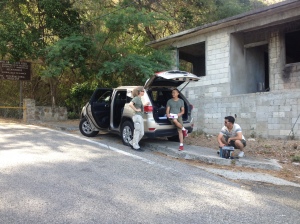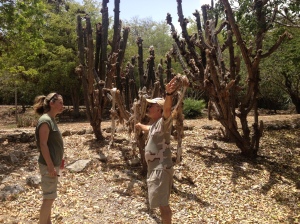So our current location is the South of the island where we are working on a site at Guanica state park which is near the city of Ponce, the second largest city in Puerto Rico. We took a day to explore some of the city when we arrived and found a lovely picturesque square in the city center. We also had great intentions of experiencing the culture and made quiet a long trek on foot to an art museum after many wrong turns in the afternoon heat only to arrive too late to go inside!!



The heat here is much drier and we’ve found it a bit tougher to work in than the previous sites which were more sheltered and humid. We try to get to the site as early as possible to get our work finished before the midday heat! We might have been a little too eager on one such morning though when we found the gates locked at 7am and ended up waiting for the ranger until 8.30!

We have been noticing very low conductance’s in the porometer measurements of the plants here and the guys suspected that this was because the plants are experiencing a water stress and are closing their stomata to conserve as much water as possible. After talking to the ranger he confirmed that they are going through an El Niño, which is a warming of the central Pacific once every few years, from a combination of wind and waves in the tropics. It shakes up climate around the world, changing rain and temperature patterns. It benefits some areas with increased rainfall and reduces harsh winters but for Puerto Rico at the moment they are experiencing a severe drought!


After surveying our site on the first day and tagging our plants we ventured to the coastal side of the state park to compare the plant life and maybe check out the beach!

After this day we decided the pants and boots were being replaced! We are working on an open trail and after being informed that there are no threats of snakes or other wildlife we opted for the cooler choice!

We spent a chilled out afternoon pressing the specimens back at the hotel later in the week. This is another technique I have picked up on this trip! I have learned how to press the plants so that both the abaxial and adaxial surfaces are facing up on some leaves to make it easier to examine them when they are dry. I’ve also learned how important it is to label things properly so you know what everything is a few weeks down the line when you get back to the lab!

In the field I’ve been intrigued by the ability of Wuu Kuang and the guys to identify plants from our list in a forest full of what I would perceive to be a lot of trees that look the exact same!! It is definitely not an easy task to go to a forest you don’t know and identify a number of new species in a few hours! I’ve picked up some really useful tips from him for identifying plants in the field, like what different traits to look for first and making and using a key! If you are prepared and you know what you are looking for then the differences between the species become very apparent! Some of these techniques I can recall from the practical classes last semester in the Diversity of plant form and function module we had.
